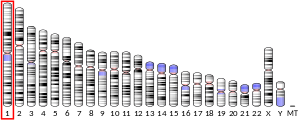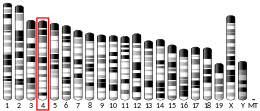HEYL
Hairy/enhancer-of-split related with YRPW motif-like protein is a protein that in humans is encoded by the HEYL gene.[5][6][7]
This gene encodes a member of the hairy and enhancer of split-related (HESR) family of basic helix-loop-helix (bHLH)-type transcription factors. The sequence of the encoded protein contains a conserved bHLH and orange domain, but its YRPW motif has diverged from other HESR family members. It is thought to be an effector of Notch signaling and a regulator of cell fate decisions. Alternatively spliced transcript variants have been found, but their biological validity has not been determined.[7]
References
- 1 2 3 GRCh38: Ensembl release 89: ENSG00000163909 - Ensembl, May 2017
- 1 2 3 GRCm38: Ensembl release 89: ENSMUSG00000032744 - Ensembl, May 2017
- ↑ "Human PubMed Reference:".
- ↑ "Mouse PubMed Reference:".
- ↑ Leimeister C, Externbrink A, Klamt B, Gessler M (Sep 1999). "Hey genes: a novel subfamily of hairy- and Enhancer of split related genes specifically expressed during mouse embryogenesis". Mech Dev. 85 (1–2): 173–7. doi:10.1016/S0925-4773(99)00080-5. PMID 10415358.
- ↑ Steidl C, Leimeister C, Klamt B, Maier M, Nanda I, Dixon M, Clarke R, Schmid M, Gessler M (Aug 2000). "Characterization of the human and mouse HEY1, HEY2, and HEYL genes: cloning, mapping, and mutation screening of a new bHLH gene family". Genomics. 66 (2): 195–203. doi:10.1006/geno.2000.6200. PMID 10860664.
- 1 2 "Entrez Gene: HEYL hairy/enhancer-of-split related with YRPW motif-like".
Further reading
- Iso T, Kedes L, Hamamori Y (2003). "HES and HERP families: multiple effectors of the Notch signaling pathway". J. Cell. Physiol. 194 (3): 237–55. doi:10.1002/jcp.10208. PMID 12548545.
- Kokubo H, Miyagawa-Tomita S, Johnson RL (2006). "Hesr, a mediator of the Notch signaling, functions in heart and vessel development". Trends Cardiovasc. Med. 15 (5): 190–4. doi:10.1016/j.tcm.2005.05.005. PMID 16165016.
- Bonaldo MF, Lennon G, Soares MB (1997). "Normalization and subtraction: two approaches to facilitate gene discovery". Genome Res. 6 (9): 791–806. doi:10.1101/gr.6.9.791. PMID 8889548.
- Firulli BA, Hadzic DB, McDaid JR, Firulli AB (2000). "The basic helix-loop-helix transcription factors dHAND and eHAND exhibit dimerization characteristics that suggest complex regulation of function". J. Biol. Chem. 275 (43): 33567–73. doi:10.1074/jbc.M005888200. PMC 2561327. PMID 10924525.
- Nakagawa O, McFadden DG, Nakagawa M, et al. (2001). "Members of the HRT family of basic helix-loop-helix proteins act as transcriptional repressors downstream of Notch signaling". Proc. Natl. Acad. Sci. U.S.A. 97 (25): 13655–60. doi:10.1073/pnas.250485597. PMC 17631. PMID 11095750.
- Strausberg RL, Feingold EA, Grouse LH, et al. (2003). "Generation and initial analysis of more than 15,000 full-length human and mouse cDNA sequences". Proc. Natl. Acad. Sci. U.S.A. 99 (26): 16899–903. doi:10.1073/pnas.242603899. PMC 139241. PMID 12477932.
- Colland F, Jacq X, Trouplin V, et al. (2004). "Functional proteomics mapping of a human signaling pathway". Genome Res. 14 (7): 1324–32. doi:10.1101/gr.2334104. PMC 442148. PMID 15231748.
- Rual JF, Venkatesan K, Hao T, et al. (2005). "Towards a proteome-scale map of the human protein-protein interaction network". Nature. 437 (7062): 1173–8. doi:10.1038/nature04209. PMID 16189514.
External links
- HEYL+protein,+human at the US National Library of Medicine Medical Subject Headings (MeSH)
This article incorporates text from the United States National Library of Medicine, which is in the public domain.
This article is issued from
Wikipedia.
The text is licensed under Creative Commons - Attribution - Sharealike.
Additional terms may apply for the media files.




